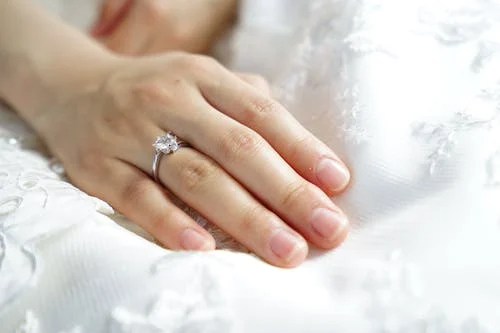How Much Should I Spend On An Engagement Ring?
0 comments
SHOP BY STYLE ✧
SHOP BY SHAPE ✧
![]()
![]()
![]()
![]()
![]()
METAL COLOR ✧
WEDDING BANDS
SHOP BY STYLE ✧
![]()
![]()
![]()
SHOP BY STONE ✧
SHOP BY METAL ✧
JEWELRY FOR THE BIG DAY
NECKLACES ✧
EARRINGS ✧
BRACELETS ✧
Engagement ✧
SHOP BY SHAPE ✧
![]()
![]()
![]()
![]()
![]()
![]()
SHOP BY COLOR ✧
SHOP BY CATEGORY✧

FEATURED✧
SHOP BY CATEGORY✧
SHOP BY OCCASION✧
SHOP BY PRICE✧

Birthstone Jewelry

The quest for the perfect engagement ring is a journey filled with hopes, dreams, and practical considerations. It’s a symbol of love and commitment, woven into the fabric of societal traditions and personal aspirations. Yet, amidst the sparkle and romance, one question often emerges with pragmatic urgency: How much should I spend on an engagement ring? This guide aims to navigate the intricate balance between financial wisdom and the emotional significance of this pivotal purchase, ensuring that you make a choice that honors both your heart and your budget.
Historically, the benchmark for spending on an engagement ring was set by the “three-month rule,” suggesting that one should allocate the equivalent of three months’ salary to this significant purchase. This guideline, however, is not a one-size-fits-all solution but rather a marketing strategy that has evolved over time. Examining its origins provides context and invites us to question its relevance in today’s diverse economic landscape.
In contemporary society, adhering strictly to this rule may not align with everyone’s financial reality or personal values. With a shift towards prioritization of experiences, financial stability, and personalized expressions of love, the modern couple is encouraged to redefine this rule to suit their unique circumstances.
Before setting a budget for an engagement ring, it’s crucial to have a clear picture of your financial situation. This includes knowing your income, understanding your expenses, being aware of any debts, and considering your savings and investments. It’s about recognizing where an engagement ring fits within your financial priorities, such as saving for a home, investing in education, or preparing for other life events.
Based on your financial overview, set a realistic budget for the ring. This doesn’t mean compromising on significance or beauty but finding a balance that won’t strain your finances. It’s about making a decision that feels right without overextending yourself, ensuring the purchase doesn’t lead to financial stress or long-term debt.
If you have a clear vision of the type of ring you want but need time to afford it, consider creating a dedicated savings plan. This might involve setting aside a certain amount monthly or cutting back on discretionary spending. The key is consistency and prioritizing this goal within your broader financial plan.
While financing can make an engagement ring more immediately accessible, it’s important to approach this option with caution. Interest rates and terms can significantly impact the total cost. If financing is considered, look for options with favorable terms, such as zero-interest promotions, and be diligent about repayment plans to avoid unnecessary debt.
Every dollar spent on an engagement ring is a dollar not allocated towards other financial goals. It’s essential to weigh this purchase against other priorities, such as emergency savings, retirement funds, or debt repayment. A balanced approach ensures that your engagement ring purchase enhances your life rather than detracting from your financial goals.
Engagement ring shopping is an excellent opportunity for couples to discuss their financial values and expectations openly. This conversation can set the tone for future financial decision-making, highlighting the importance of alignment and mutual understanding.
It’s natural to desire the perfect ring to symbolize your love, but it’s equally important to balance these desires with the reality of your financial situation. Compromise doesn’t mean settling for less but finding a solution that respects both partners’ wishes and financial health.
While an engagement ring symbolizes love and commitment, it’s also a significant financial investment. Considering its long-term value, both emotional and financial, can influence your budgeting decision. Some may prioritize the ring’s quality and potential heirloom status, while others might focus on its symbolic value over material worth.
Maximizing value when shopping for an engagement ring doesn’t necessarily mean spending less; it’s about making informed decisions that ensure you get the best quality and significance for your budget.
The Four Cs—Cut, Color, Clarity, and Carat—are the global standard for assessing the quality of diamonds. Understanding these can help you decide where to compromise and where to splurge to get the best value.
Diamond prices can jump significantly at full and half-carat weights. Choosing a diamond just under these popular weights (e.g., 0.95 carat instead of 1 carat) can offer a nearly imperceptible difference in size but a noticeable difference in price.
A well-chosen setting can enhance the overall appearance of the ring and make the center stone appear larger. Halo settings, where the center stone is surrounded by smaller diamonds, or choosing a slender band, can make the main diamond seem more substantial.
Decide which aspects of the ring are most important to you and your partner. Is it the size of the diamond, the overall design, the quality of the stone, or perhaps the ring’s origin and sustainability? Prioritizing your values can help you determine where to allocate your budget.
By applying these practical tips, you can navigate the complexities of purchasing an engagement ring with confidence, ensuring that you find a piece that represents your love and commitment without compromising on value and quality.
In conclusion, integrating personal finance into the decision-making process for an engagement ring purchase is about more than just numbers. It’s a holistic approach that considers emotional desires, financial health, future goals, and the shared values of a couple. By prioritizing open communication, realistic budgeting, and informed choices, couples can ensure that their engagement ring symbolizes not only their love and commitment but also their shared journey towards a secure financial future.